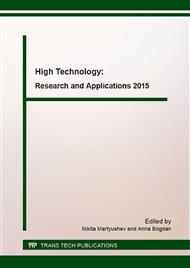[1]
Z. S. Olesiak, Problems of thermodiffusion of deformable solids, Materials Science, 34 (3) (1998) 297–303.
DOI: 10.1007/bf02355619
Google Scholar
[2]
Qi Min Wang, Kwang Ho Kim, Microstructural control of Cr–Si–N films by a hybrid arc ion plating and magnetron sputtering process, Acta Materialia, 57 (2009) 4974–4987.
DOI: 10.1016/j.actamat.2009.07.001
Google Scholar
[3]
W. Ernst et al. Thermal decomposition routes of CrN hard coatings synthesized by reactive arc evaporation and magnetron sputtering, Thin Solid Films, 517 (2008) 568–574.
DOI: 10.1016/j.tsf.2008.06.086
Google Scholar
[4]
Asaro R. J., Farkas D., and Kulkarni Y. The Soret effect in diffusion in crystals, Acta Materialia, 56 (2008) 1243–1256.
DOI: 10.1016/j.actamat.2007.11.019
Google Scholar
[5]
K. I. Morozov, Soret effect in molecular mixtures, Physics Review E, 79 (2009) 031204.
Google Scholar
[6]
M. A. Rahman & M. Z. Saghir, Thermodiffusion or Soret effect: Historical review, International Journal of Heat Mass and Transfer, 73 (2014) 693–705.
DOI: 10.1016/j.ijheatmasstransfer.2014.02.057
Google Scholar
[7]
N. Herbots et al., Atomic collisions, elastic recombination, and thermal diffusion during thin-film growth from low-energy ion beam, Nuclear Instruments and Methods in Physics Research, B59/60 (1991) 326–331.
DOI: 10.1016/0168-583x(91)95233-4
Google Scholar
[8]
N.N. Rykalin, A.A. Uglov, Laser and electron beam treatment of materials. Directory, (1985).
Google Scholar
[9]
V.I. Rudakov, V.V. Ovcharov, Mathematical description of the diffusion in a temperature field and measuring the heat of transport, Intrenational Journal of Heat and Mass Transfer 45 (2002) 743–753.
DOI: 10.1016/s0017-9310(01)00204-6
Google Scholar
[10]
C. Korte, J. Janek, H. Timm, Transport processes in temperature gradients Thermal diffusion and Soret effect in crystalline solids, Solid State Ionics 101-103 (1997) 465-470.
DOI: 10.1016/s0167-2738(97)84069-6
Google Scholar
[11]
D. V. Alexandrov and D. A. Pinigin, On the Theory of Dendritic Growth: Soret and Temperature-Dependent Diffusion Effects, Russian Metallurgy (Metally), 2013 (2) (2013) 123–129.
DOI: 10.1134/s0036029513020031
Google Scholar
[12]
N. S. Kostyukov, Relationship between thermal diffusion and conductivity for two-component crystalline structures, Journal of engineering physics, 10 (2) (1966) 101-102.
DOI: 10.1007/bf00834545
Google Scholar
[13]
H.S. Carslaw and J.C. Jaeger, Conduction of heat in solids: (2nd Edition), Clarendon Press, Oxford, (1959).
Google Scholar
[14]
A.G. Knyazeva, M.V. Chepak-Gizbrekht, The influence of thermodiffusion on the alloying element distribution between coating and base surface treatment conditions, Russian Physics Journal, 56 (12/2) (2013) 46-52.
Google Scholar
[15]
O. N. Kryukova, M. V. Chepak-Gizbrekht, The Influence of Thermal Diffusion on the Redistribution of Alloying Element between the Coating and Base under Surface Heating, Advanced Materials Research, 1040 (2014) 602–607.
DOI: 10.4028/www.scientific.net/amr.1040.602
Google Scholar
[16]
A. G. Knyazeva, A. P. Savitskii Estimating volume changes in the diffusion zone. 2. Interaction of two finite media, Russian Physics Journal, 40 (6) (1997) 546-553.
DOI: 10.1007/bf02766386
Google Scholar
[17]
A. G. Knyazeva, A. P. Savitskii Estimate of volume changes in the diffusion zone, Russian Physics Journal, 40 (5) (1997) 420-427.
DOI: 10.1007/bf02508770
Google Scholar
[18]
A. G. Knyazeva, I.G. Dik, Ignition of a hot sheet of condensed material through an inert shield, Combustion explosion and shock waves, 26 (2) (1990) 133-142.
DOI: 10.1007/bf00742397
Google Scholar
[19]
A. G. Knyazeva Approximate estimates of the characteristics of propellant ignition using radiant flux through shields with various properties, Combustion explosion and shock waves, 32 (1) (1996) 22-35.
DOI: 10.1007/bf01992187
Google Scholar
[20]
Physical values. Handbook. Edited by I.S. Grigor'ev, E.Z. Meilihov, Moscow: Energoatomizdat, (1991).
Google Scholar


